Materials & Waste Progress, 2018-22
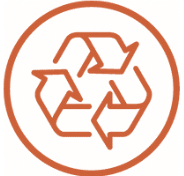
We strive for sustainable consumption and diversion practices by considering sourcing, usage, durability, and end-of-life at the time of purchase.
2018 Pitt Sustainability Plan Goals
- Purchase: Establish procedures, policies, practices, and educational tools to reduce the quantity and environmental impact of materials entering and exiting the University.
- Building Materials: Use healthy products for our built environment in accordance with future Pitt Green Building Standards.
- Landfill: Reduce landfill waste 25% by 2030 from 2017 levels.
- Compost: Expand the food waste composting program to compost 50% of food waste by 2025.
Where We Are: Sustainable Purchasing
The University of Pittsburgh aims to both integrate the tenets of sustainability into University-wide procurement policies and guidelines, and put into place the support mechanisms for these efforts to proliferate via departmental procurement practices.
Sustainable Contracted Suppliers: Pitt’s contracted suppliers and purchasing processes are set up to help campus purchasers choose more sustainable items from more diverse and local companies, while still getting the best price and adhering to the University’s financial requirements. Pitt’s procurement teams work with every contracted supplier to help ensure offerings are sustainable and suppliers diverse. Contracted suppliers provide clear environmental impact information for the life cycle of their products and services – and are easily searchable online by whether or not they offer “green” options.

Though the University’s campus-wide office supply contract was consolidated in 2014, new sustainability initiatives and offerings since 2017 have helped ensure that the University’s partnership with SUPRA and ODP Business Solutions (formerly Office Depot). Examples include K-cup recycling, a regular “Business Solutions Sustainability Show,” and the reusable desktop delivery Green Tote program (launched in 2022).
Strategic Sourcing: Since 2017, sustainability has been expanded within and strategically infused into and a number of supplier contracts, including:
- Food Services: Pitt Sustainability Plan goals are embedded into this 10-year Pitt contract, inked in 2020 with Chartwells (referred to as Pitt Eats). Partnerships and key performance indicators focus on the Real Food Challenge, Cool Food Pledge, to-go reusables, and waste reduction.
- Hazardous Waste: Pitt’s Environmental Healthy, & Safety department has been focused on environmentally friendly waste treatment methods for over 15 years, including striving each year towards increasing the amount of chemical waste that is recycled, re-used or re-purposed. In 2020, Pitt updated its hazardous waste management contract with Veolia to increase the focus on lessening the impact of proper chemical waste disposal on the environment; as a result, in 2022, 70% of Pitt’s chemical waste was processed via waste to energy, fuels blending, or other sustainable options.
- Janitorial Products: Clarified and embedded green cleaning product requirements and tracking in University-wide procurement.
- Managed Print: In FY23, the University put its managed print services contract out for bid, with the intention of optimizing campus-wide standalone printers and multifunction devices, while ensuring consistent service.
- Pouring Rights: Contracted to offer healthy drink options on campus, while supporting campus-wide transition to more sustainable packaging options and reducing vending machine energy use.
- Scientific Supplies: Updated in January 2023, Pitt’s third-largest contract (for scientific supplies) is held by Fisher Scientific, which supports laboratory sustainability through dedicated project funding focused on diverting polystyrene and hard plastics from landfills and circular economy solutions. The new Fisher Scientific contract also includes support for sustainability research, internships, and education.

Where We Are: Healthy Building Materials
Pitt’s design guidelines for architectural, engineering, and construction professionals address many important indoor health and materials considerations, especially through Division C: Architectural Design Guidelines for Sustainability, Products and Materials, which was updated in November 2019 with holistic practices in mind and is utilized on all University projects managed by Design & Facilities.
Healthy Materials: In addition to Pitt’s design guidelines, LEED and other third-party green building rating systems are used to incorporate consideration of healthy indoor environments through both materials selection and consideration of indoor environmental quality.
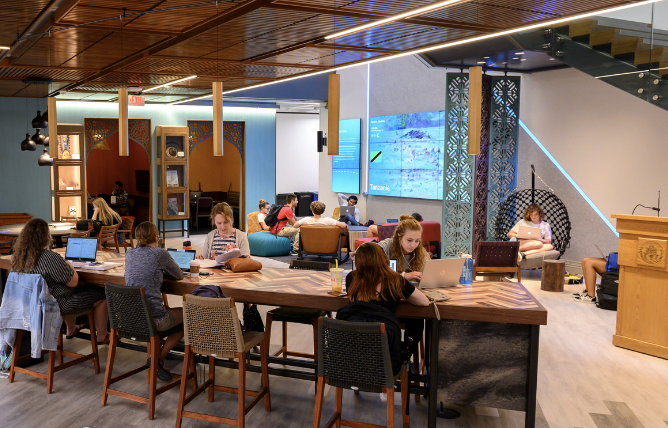
Healthy and sustainable material considerations incorporated into Pitt spaces include material and product content, type, and sourcing; reduction of heavy metals in building materials; and overall life cycle impact reduction (i.e., embodied carbon).
Indoor environmental quality considerations include (but not limited to) indoor and outdoor air quality; low-emitting materials; thermal, acoustic, and lighting comfort; and access to daylight and aesthetic views; indoor air quality are addressed in the “Health & Wellness” section.
Where We Are: Materials Education
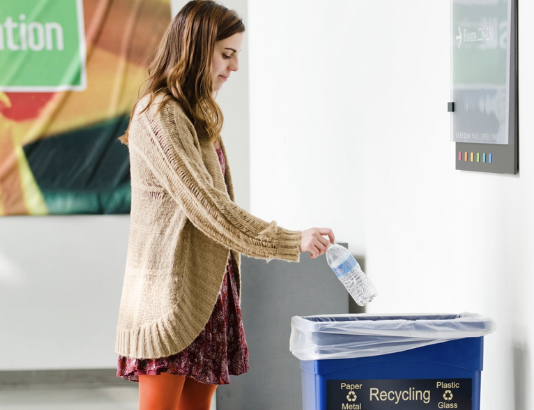
Campus-wide Materials Diversion Signage: In 2019, multiple Pitt departments collaborated to update University-wide waste and materials diversion signage as part of a concerted effort to encourage waste reduction across the campus. Work to install this signage campus-wide is still in progress; it is publicly available online for download and use across campus.
Race to Zero Waste (formerly Recyclemania): Starting in 2010, the University of Pittsburgh has annually participated in the national Campus Race to Zero Waste competition, which includes campus-wide education about zero waste and recycling programs, alongside materials diversion tracking. Notable achievements from 2018 through 2020 include:
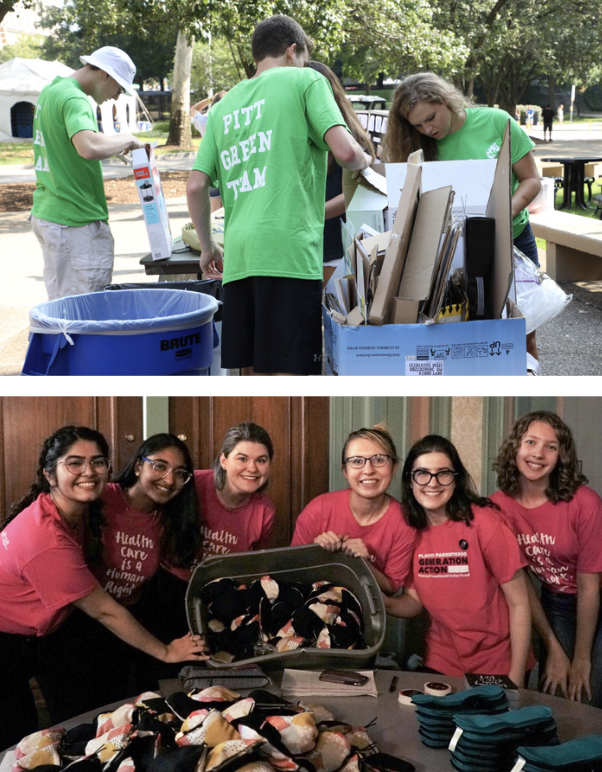
- 2018 – Over the 8-week competition, Pitt diverted 45.5% of materials from landfill at a rate of 25.6 pounds per capita. The “Game Day Challenge” basketball game diverted 46.7% of all materials from landfill, ranking Pitt #7 among competitors in this category.
- 2019 – Pitt diverted 38% of materials from landfill at a rate of 19.8 pounds per capita. The “Game Day Challenge” basketball game diverted 18.3% of all materials from landfill from a game attended by 10,289 people.
- 2020 – Recyclemania was truncated due to the pandemic, but Pitt maintained a 38.5% campus-wide diversion level, but was #25 overall in the per capita category at 14.8 pounds per person.
- 2021 & 2022 – Due to the pandemic, Pitt did not publicly log materials diversion, but provided copious virtual educational and engagement opportunities in 2021 and a mix of in-person and virtual events in 2022.
- 2022 – Pitt menstrual health equity case study won first place in case study competition, “Education and Awareness” category.
Where We Are: Culture of Reuse
Approaching the campus and global materials challenge with a variety of zero waste strategies is important, including ways to: Rethink, Refuse, Reduce, Repair, Reuse, and Recycle materials. Several “refuse” strategies with BYO bags and to-go containers are included in the “Food Systems” section. Examples of “rethinking,” “repairing,” and “reusing” efforts are below.

Surplus: Established in 1980, the University of Pittsburgh’s Surplus Property operation has collected used items from departments across the University to facilitate the resale or donating of items to other departments, local organizations, and the public. From 2018 through 2022, Surplus helped divert thousands of items from the landfill (including office furniture, lab equipment, musical instruments, computers, and even vehicles); during this time period, Pitt Surplus recycled over 246 tons of scrap metal.
University of Thriftsburgh: The University of Thriftsburgh is a student-founded and -operated thrift store on campus open to the Pitt community and public to buy and donate secondhand clothing and accessories. Thriftsburgh officially opened its doors in March 2015 and has been growing since, helping to reduce textile waste, cut carbon, and promote a culture of reuse. In Fall 2022, Thriftsburgh had over 600 separate transactions, each helping materials find their next, best life.
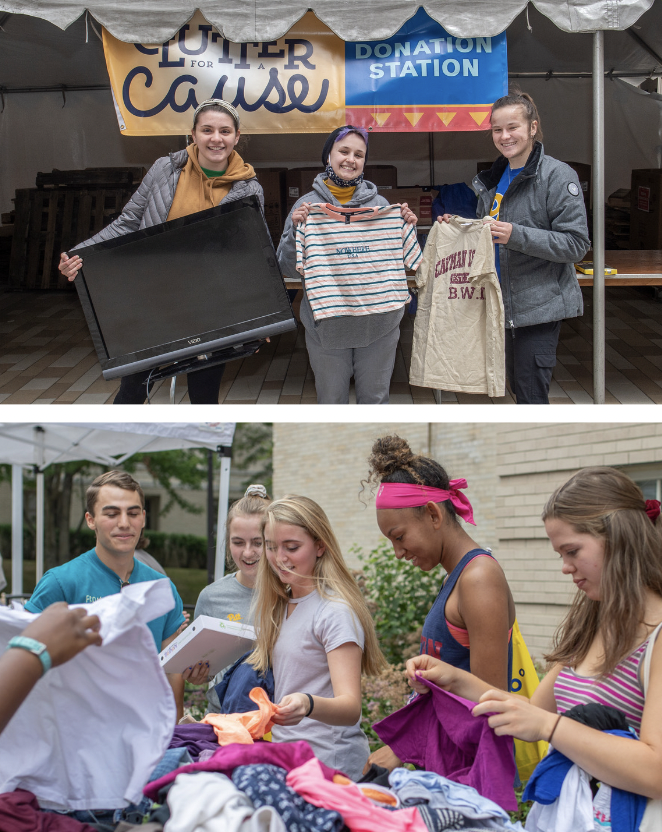
Clutter For a Cause: Since 2013, Pitt has hosted a zero-waste move-out process with Clutter for a Cause. The multi-day event collects clothing, textiles, dorm room essentials, electronics, and non-perishable food items from both on- and off-campus locations at the end of the academic year in May and June. Led by the cross-departmental sustainability team with many partners, Clutter for a Cause helped keep 44,443 pounds of materials out of the landfill from 2018 to 2022. In Spring 2022, Clutter for a Cause collected a record breaking 21,689 pounds of materials (over 10 tons) during student move-out that may have otherwise gone to landfills.
Clean & Swap: Held for the first time in 2020 and repeated in 2022, Pitt’s Clean & Swap program is an opportunity for employees and departments to de-clutter their workspaces by donating unwanted items to be reused within the University or donated to local nonprofits. The inaugural event in 2020 collected 728 pounds of unwanted office items. In 2022, over 3,155 pounds of office and medical supplies were collected and diverted from landfills.
Where We Are: Materials Redirection
In line with reducing landfill waste campus-wide 25% by 2030 (from 2017 levels), the University attempts to find the next highest and best use for materials, including the examples below:
Textile Recycling: Recognizing that clothing and textiles make up ~6.3% of the U.S. waste stream, Pitt launched textile recycling collection and diversion on the Pittsburgh campus in January 2020. From 2019 to present, Pitt has diverted over 30 tons of textiles from the landfill and back into the circular economy; the offering is the foremost topic of public external inquiries to the Office of Sustainability.
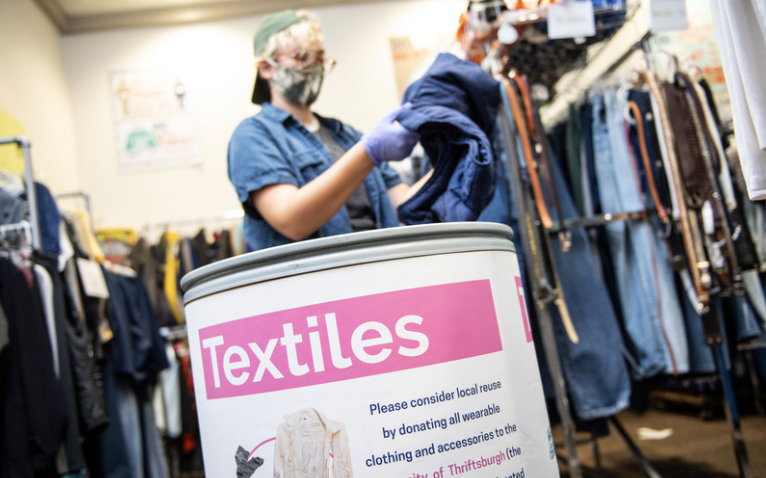
Zero Waste Period Initiative: In 2020, the student-led Zero Waste Period collaboration won a Pitt Sustainability Award, recognizing their efforts distributing 650 reusable menstrual products over just 2 years. Campus wide zero waste period and menstrual equity is an ongoing initiative, as described in the “Equity & Access” section.
Dorm Mattresses: The University of Pittsburgh regularly ensures its mattresses from residence halls and multifamily apartment buildings are diverted from landfill to recycling. From 2018 through 2022, Pitt diverted 1,474 mattresses to recycling or reuse. When 500 dorm mattresses and bed frames were removed in 2021 as part of a residence hall remodeling project, Pitt partnered with local nonprofit Global Links. The beds were cleaned and repurposed and donated to locations in Nicaragua and Honduras that provide expectant mothers a place to rest and heal pre- and postpartum.

Where We Are: Materials Diversion
Materials to Landfill: The University’s goal is to reduce landfill waste 25% by 2030 (from 2017 levels); calendar year (CY) 2021 material and waste data show overall materials to landfill were down 37.2% from the CY17 baseline. While this absolute reduction is far ahead of the 7.7% incremental goal for CY21, both CY20 and CY21 campus activity and materials were heavily pandemic-influenced; it is unclear whether these reductions are durable.
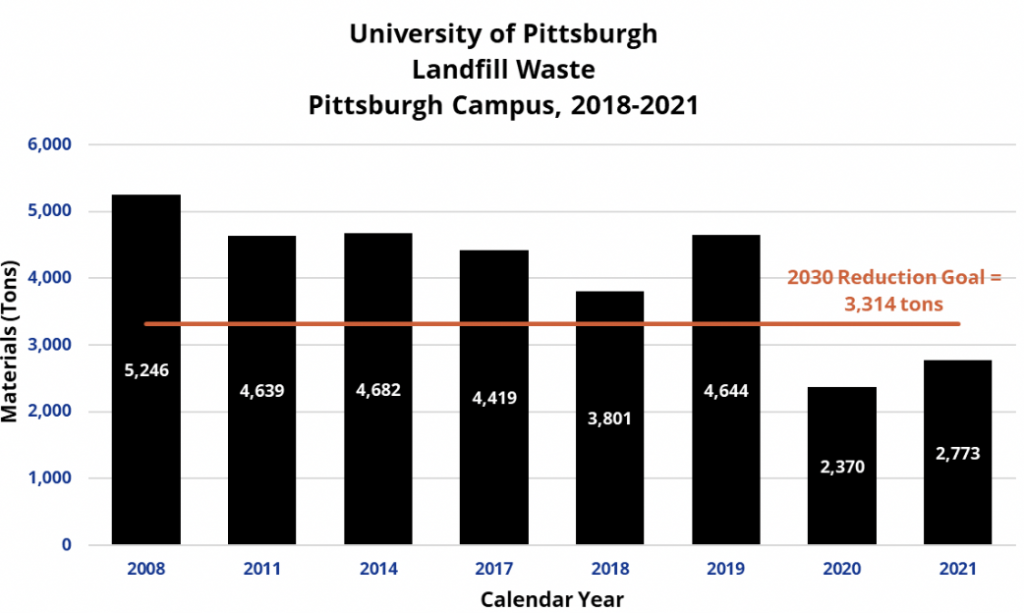
Recycled Materials: The University of Pittsburgh began recycling in 1990; single stream recycling rates gradually grew from 22.7% in 2008 to 32.4% in 2017. Standard campus-wide single stream recycling accepts cardboard, glass, metals, plastic, and paper (including books).
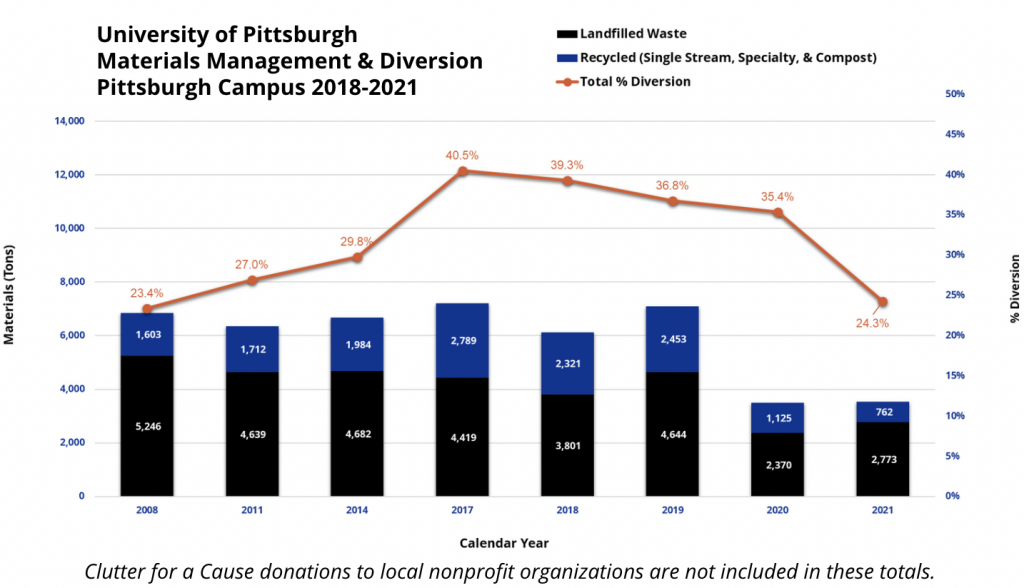
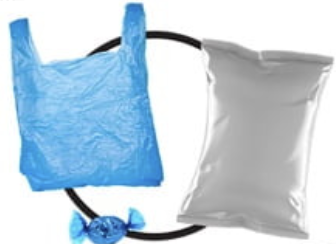
Global recycling changes in 2018 also impacted local options – and Pitt’s campus-wide single stream recycling rates decreased dramatically (reflecting national trends). The global COVID-19 pandemic also dramatically impacted both quantities, types, and diversion from landfill abilities for campus materials such as the shift to takeout-only dining that required the use of hundreds of thousands of single-use takeout packages.
Specialty Recyclables: Beyond single stream recycling, the University also recycles batteries, carpet, chemicals, compostables, corrugated cardboard, electronic equipment and devices, fluorescent light bulbs, mattresses, surplus items (including white goods), textiles, toner and ink cartridges, K-Pods, pharmaceuticals, and gloves (2019-22 pilots in labs and Housing).

Print Reduction: While both Pittsburgh campus paper use and metered print is down nearly 70% between FY18 and FY22, the University has identified ongoing opportunities to retain and build upon digital adoption trends through a print reduction initiative. In addition to reducing paper, ink, and energy usage, reducing print will help save the University time and money.
Where We Are: Compost
University-wide diversion of compostable materials from landfill started in 2015, during which 1,200 pounds were collected from campus. Since then, campus-wide compostable collection and diversion has scaled up across campus, with consumer-focused collection expanded to 8 Pittsburgh campus buildings in 2019.
In 2020, the University launched its Compostable Collection Dashboard to show campus-wide diversion of compostable materials monthly by building. Pre-pandemic, fiscal year 2020 was on track to be Pitt’s highest compost diversion year ever. Despite setbacks, in FY21, a new vendor partnership allowed a brief expansion of pre-consumer compostable material diversion from residential and retail dining locations.
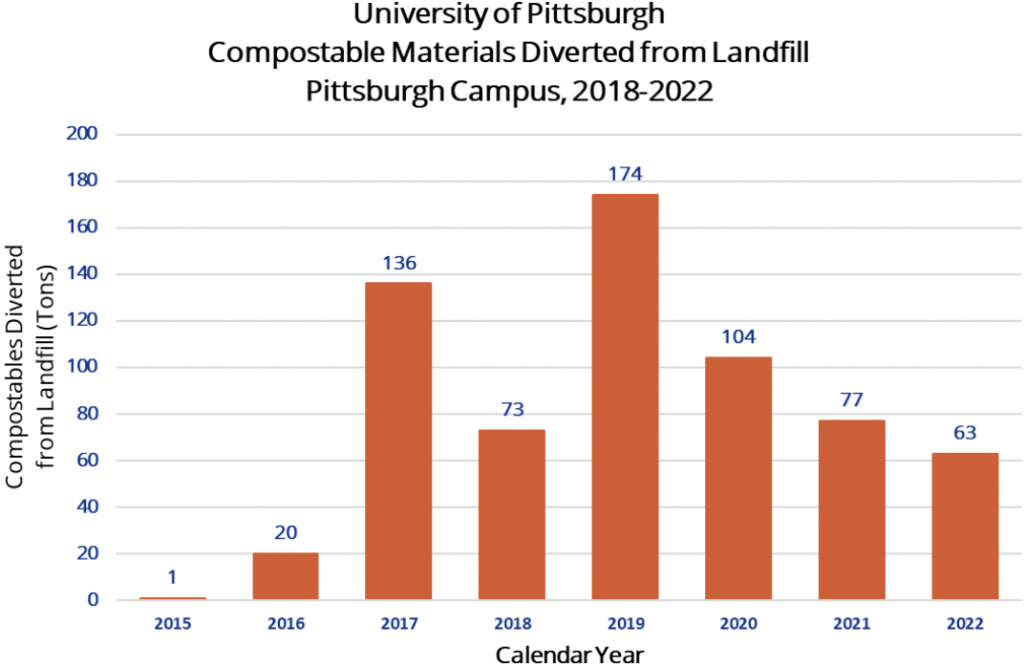
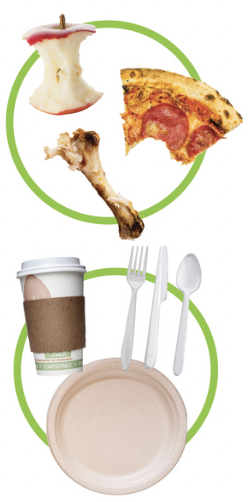
Progress towards the goal of expanding food waste composting to compost 50% of food waste by 2025 is unclear, but undoubtedly off track. No baseline of food waste campus-wide exists, in part because various approaches over the years have helped ensure that not all campus food waste is wasted; these include strategies include a graywater digester at The Eatery dining hall, food recovery (addressed in the “Food Systems” section), and educational campaigns, including student-led food waste audits to reduce dining hall waste. Campus-wide food recovery alone ensured over 108,000 pounds of food made it not just to landfill, but to people in need from 2018 through September 2022.

As an alternative to compostables, Pitt Sustainability Plan “Food Systems” goals focus on expediting the shift to reusable to-go beverage and food containers. Pitt’s residential dining (The Eatery and The Perch) are reusable by default; on-campus catering also offers reusable serving and dinnerware for events. While the University remains committed both to reducing food waste overall and increasing composting food waste and compostable materials, the actual goal and timeline likely need to be reassessed.
Where We Are: Materials Research
University of Pittsburgh faculty have received funding for and published research on a variety of sustainable materials. Examples from 2018 through 2022 include but are not limited to solar power end of life; circular economy (described in the “Research” section); sustainable healthcare, oncology, medical devices, and surgeries (with collaborations between Pitt Engineering, Health Sciences, and UPMC).
Nonconventional Materials – Pitt NOCMAT (Nonconventional Materials and Alternative Technologies) engages in cutting-edge engineering research and service-learning education involving sustainable, locally sourced, non-conventional materials adapted to lower technology production environments.